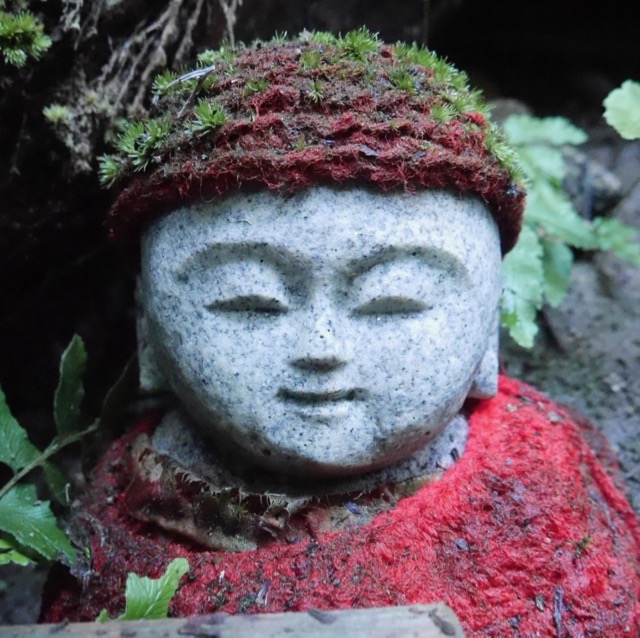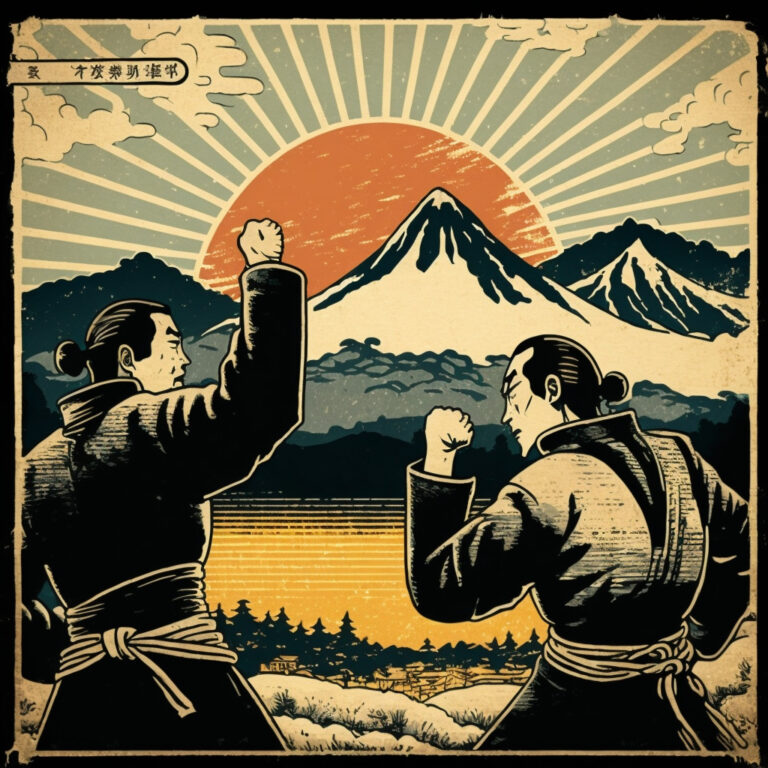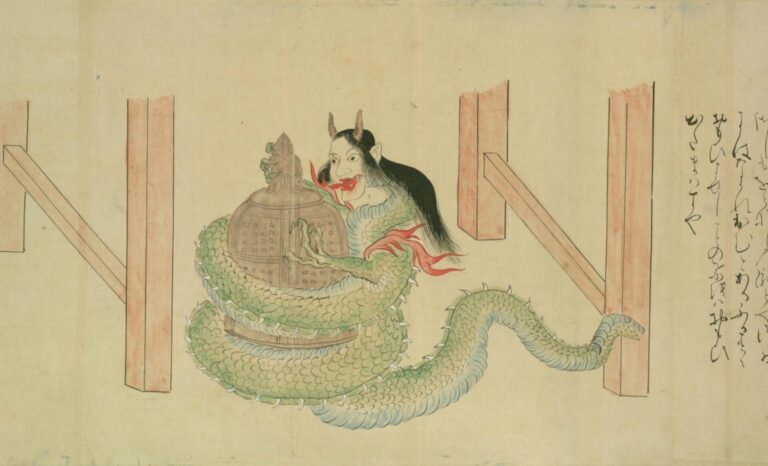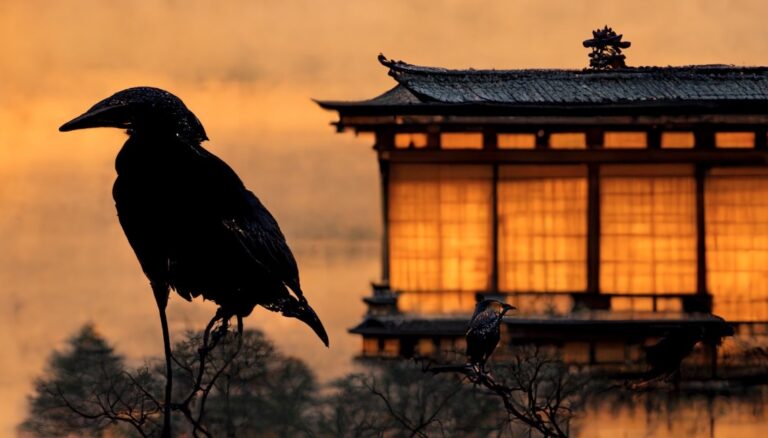This is Thersa Matsuura and you’re listening to Uncanny Japan.
Let’s pretend it’s, oh, I don’t know, the year three hundred and something and you’re a peasant living in the Japanese village of Hiomo (日面) way up on top of Mount Dewa ga Hira (出羽が平の山) in Gifu. You have been tasked with the job of keeping the monkeys away from the crops. You’re really good at it, too. The best monkey-keeper-awayer the village has ever seen.
Your method is something like this: You walk the perimeter of the field, armed with a stick. When any of the nasty little beasts descend, you chase after them, swinging your weapon and screaming like a mad person. They scamper away, knowing not to mess with you. A job well done.
Well, on this particular day, after you’ve shooed away the usual number of hungry chimps, there is a huge racket in the distance. It sounds as if part of the mountain itself has fallen away. You, as well as the rest of the villagers, hurry to see what’s happened.
You find part of the mountain has indeed fallen away, revealing a large gaping hole. Well, that’s never happened before. Curious, you and the others creep closer to investigate when all of the sudden from the cave emerges a six-meter (almost 20-foot) tall man-creature.
But not your ordinary six-meter tall man-creature. This one has two faces. A normal one where you’d usually find a face, then a second one on the back of his head, facing the opposite direction. It’s almost as if you took two giant people and pressed them together back to back, merged them. Because he also has four arms and four legs. But it gets worse. This giant is wearing armor and carrying a halberd.
All hell breaks loose. Everyone gathered is screaming and running around. You’re frozen. You gawk and drop your stick.
This man-creature draws himself to his full height and looks down, clears his throat, then loudly announces that his name is Sukuna. He goes on to say:
“Be not afraid! I have appeared in this world to protect the Buddhist Law and uphold the law of the rulers. I am here to serve.”
Now amidst this utter chaos of villagers panicking, you keep your wits about you. You go over and prostrate yourself in front of the giant.
“I wish to obey your command, but your stature is too large for my humble abode.”
Understood. Sukuna forms his hands into a special sacred mudra and instantly shrinks and transforms into an 11-faced Kannon statue.
You gently and respectfully pick up the effigy and carry it back to the village of Hiomo where you keep it in your house. In time you ditch the monkey chasing gig and build a hermitage to serve Sukuna.
Okay, that’s my rendition of one of the tales of this mysterious and powerful god or beast (there is some confusion) named Sukuna. Or Ryomen Sukuna. Sukuna of the two faces.
Full disclosure: the monkey chasing thing wasn’t a part of the story. But the rest of it is. Today let’s talk about this two-faced, eight-limbed, multi-weaponed giant.
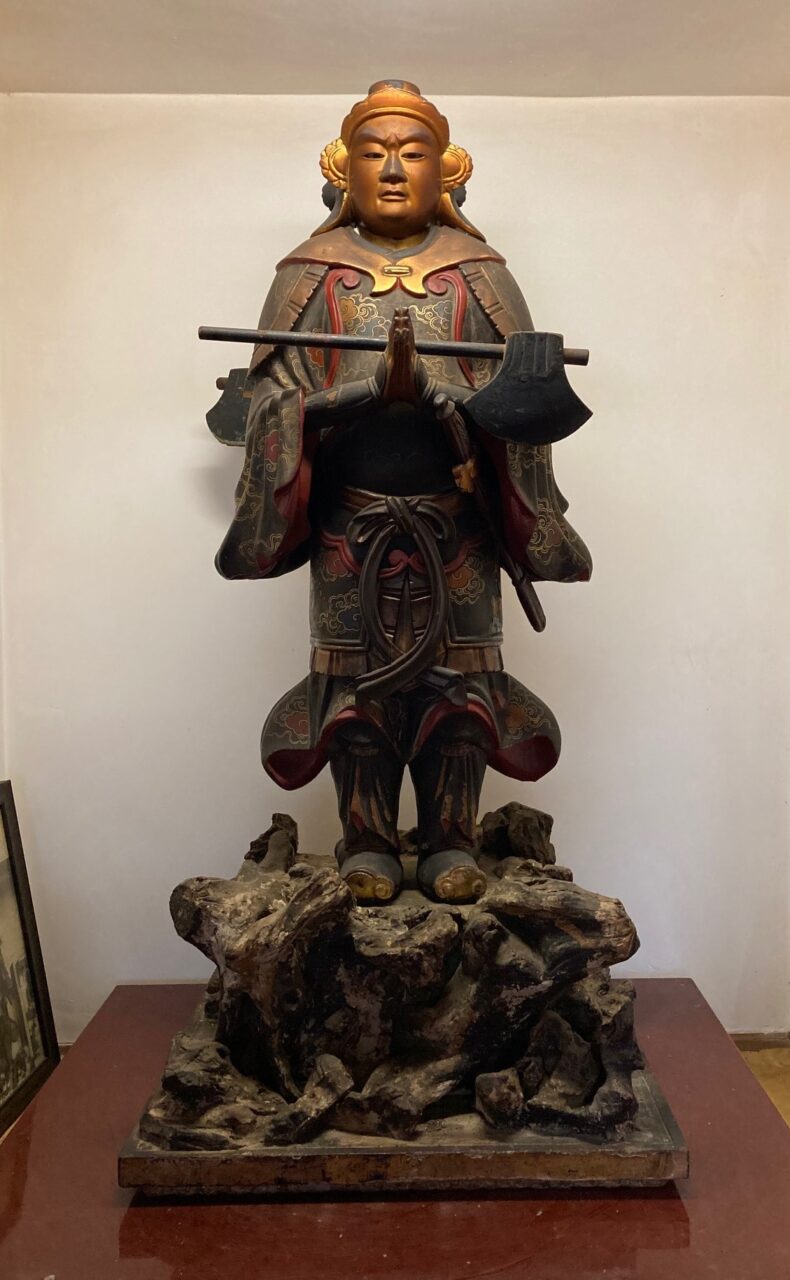
Hey hey, how are you? I wanted to start off by giving a big thank you to everyone who has preordered The Book of Japanese Folklore. I don’t want to jinx it — so knock on wood — but for the past couple of weeks different versions of it (either the hardcover or the kindle) have been #1 on the New Release Amazon bestseller list for either “Mythology & Folklore Tales Literary Criticism” or “Mythology and Folklore Encyclopedias.” So thank you and big hugs. Because those pre sales can’t all be my mom. Can they?
Okay, okay, you say. Tell me more about this two-faced giant. And that I will.
Anyone who is familiar with the manga and anime Jujustsu Kaisen by Gege Akutami, knows the name Ryomen Sukuna. The gist there is that high school student Yuji Itadori joins a secret society of sorcerers. But he’s no Harry Potter, because, long story short, Yuji-kun ends up eating one of Sukuna’s cursed mummified fingers, making him the host for this super villain, Ryomen Sukuna — who has absolutely no redeeming qualities, it seems. I haven’t read or watched Jujutsu Kaisen, but I did checkout a run down of the first season and it sounds really fun and I think that if I had more time, darn-it, I’d give it a read or watch. I’m quite intrigued.
That said, is it a fair depiction to show Sukuna as so entirely evil and unredeemable? I mean the story I started out with doesn’t portray him that way. He turned into a statue of the benevolent and wholly compassionate Kannon.
So what do you think? Let’s dig in.
The Sukuna story is incredibly old, first appearing in the Nihon Shoki — which you’ll remember was written in the 8th century. There’s a short entry that goes something like this:
“In 65th year, under the reign of Emperor Nintoku in Hida Country, there was a man. His name was Sukuna. He had one body and two faces. One on the back of the other so that they faced in opposite directions. The body, too, had four arms and four legs. The legs had knees but no heels. He was extremely powerful yet agile and carried a sword on both his left and right sides. He could also use a bow and arrow in any of his four hands. He did not obey imperial orders and enjoyed plundering people. Because of that, the ancestor of Wani-uji — Naniwa no neko takefuru kuma (難波根子武振熊) was sent to kill him.”
That’s it. How could they leave us hanging like this?
But don’t you worry, his story doesn’t end there. Here’s a similar legend to that first one I told. In this one, though, the temple is actually named. It’s Senkouji in Gifu Prefecture.
A tiny aside about Senkou Temple because I was reading about it and gasped out loud.
The temple is said to have been founded by Ryomen Sukuna who lived at the foot of the mountain, 1600 years ago. During the Heian Era it received the patronage of the Imperial Court and flourished. It had 19 sub temples on the mountain and an absolute wealth of scrolls, scriptures, statues, artwork, and important Kasa (buddhist robes) were all enshrined there.
Well, in 1564, during the Sengoku or Warring States Period, along comes the Takeda army from Kai. They invaded Hida (where Senkouji and all those precious temples and Buddhist items were located) and burned it all down. Lit the entire mountain on fire. Everything was destroyed, except, someone managed to save the main deity. Which I’m guessing is the Kannon statue. To this day it’s still kept secret but every seven years there’s a special ceremony for it. The temple and sub temples were rebuilt little by little throughout the years.
I’m sitting here imagining the absolute horror of being a monk on the mountain when you’re suddenly surrounded by fire and trying to escape with your life, but also save some precious items. Takeda!
Anyway, the following tale — dated 1621 — states that during the reign of Nintoku there was a person named Sukuna who emerged from a cave in Dewa ga hira. He was 18 meters tall and had two faces, four arms, and four legs.
He was believed to be an incarnation of the Bodhisattva Kannon and actually founded the Senkou Temple. It was also at this time at the top of the mountain a sealed box containing part of the Lotus Sutra, a Buddhist robe, and a statue of the Senju (one thousand-armed) Kannon was unearthed. But that’s not all, this two-faced, eight-limbed wonder also founded the nearby Zenkyuji Temple, too.
There he was described as appearing wearing armor, holding a spear in one hand, a regular staff in another hand, an octagonal cypress staff in a third hand, and an ax in that fourth one. I bet that was a sight.
This version of Ryomen Sukuna was said to have been ordered by the emperor to defeat an oni named Shichinō (七儺) (which means Seven Perils) who lived near Mount Iyama in Takayama City. Which he did. Some hair from this demon was procured and is still in existence today. It’s one of the sacred treasures of the area.
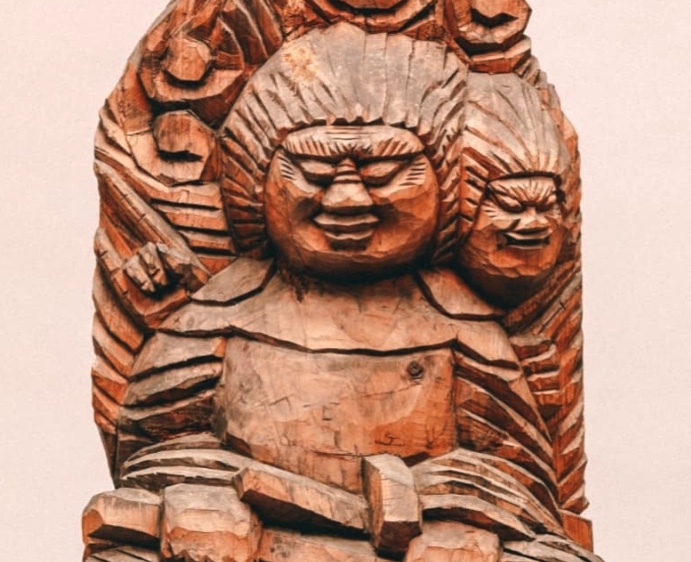
Still another variation of the tale — the Kinzan History — says that there was a powerful local person named Sukuna who heard that Takefurikuma was coming after him to murder him. So he left Dewa ga hira and stayed on the sacred Mount Kinzan for 37 days. After this he moved to another mountain and barricaded himself there but, alas, was killed nonetheless.
A slightly different take on this one is that he literally flew from one mountain to the next where he chanted the Dainichi-kyo Sutra for 37 days. What was he praying for? Why the safety of the nation and abundant harvests, of course.
There are also tales of Sukuna defeating a poisonous dragon and stabbing a cane or staff into the ground, from which grew a thousand cypress trees.
So in the Gifu region Sukuna-sama is deified and believed to be the founder of Buddhism. Only, Buddhism arrived in Japan in the 6th century and the Sukuna legend happened in the 4th. Go figure.
So why the bad rap? Well, let me tell you about and urban legend. Those are always fun. It goes like this. One day during the Taisho Era in Iwate Prefecture a team was dismantling an old temple when they came across a 2-meter long, dark wooden box. It had old torn and faded paper on it and was nailed shut. The workers asked the site manager what to do. The site manager called the head abbot of the temple and the head abbot said, Whatever you do, don’t open. Don’t even touch it. I’ll be there tomorrow morning to retrieve it.
So the site manager tells the workers to leave it alone. The next morning, though, he shows up to work and finds everyone gathered around. What happened? It seems two of the part-time employees got there early and opened the box. They were now sitting on the floor totally spaced out, drooling, and non responsive.
A quick aside: Most versions of the story I read say they were foreigners and I mention it because it’s part of the legend. But I’m going to believe that that bit of information isn’t to be prejudiced against foreigners, but just to give a valid reason why someone would open the box. Maybe there was a miscommunication or cultural difference or something.
Anyway, the site manager goes over to the now-open box and sees the horrific mummy inside. Two heads and four arms. The monk arrives, sees the box has been opened and is livid. After the site manager explains what happened, the head monk goes, well, those two are beyond saving, but I’ll perform a purification ritual on all of you. It might help a little.
His last words upon leaving the place are, “I’m so sorry for all of you. None of you will live long lives.”
That night one of the part time workers who opened the cursed box has a heart attack and dies. The other ends up in a psychiatric ward where he spent the rest of his days. Of the other employees, one came down with a mysterious high fever and another stepped on a nail and needed five stitches.
Among the faded words written on the washi paper that had been glued to the top of the box, were the words Ryomen Sukuna. The site manager did some research and found this Sukuna fellow was a strangely-shaped kijin (鬼神) — the characters for oni demon and god. This Sukuna was from a race of people called the Sukuna-zoku who refused the rule of the emperor and were wiped out. Remember that for later.
Further investigation found, though, the story of this Sukuna figure was a little different. Evidently, during the Taisho Era a pair of conjoined twins was born in Iwate where they lived, but were eventually sold to a misemono. Remember I talked about them back in episode 84? It’s like an old fashioned carnival or freak show.
Another aside: It’s gonna get a little violent, over the top gross, and dare I say silly here for a minute. Just a heads up.
So after some years, the twins become young adults and along comes an evil rich person who purchases them and takes them to his lair. I say lair, probably not lair. But what’s about to happen sounded like it would take place in a lair.
There he has several other people he has bought throughout the years from other misemono and has imprisoned there. The twins are the final piece to his wicked plan, to make the strongest and most deadly curse. And this is how he’s going to do it.
First, Hhe’ll have the prisoners all fight each other ala Battle Royale or Hunger Games, but think more inclosed space and cannibalism. Second, he’ll save the last one standing, judging them to be the strongest. This happens to be the twins. Next, just to be even more of a psychopath, he locks them in a room and starves them to death. He plans to make a sokushinbutsu. Not a real one, mind you. Remember I talked about sokushinbutsu on one episode — real life monks who would request to be locked away as to not eat, meditate and eventually gain enlightenment in death. Not the same thing but, the crazy evil guy is crazy evil.
After the poor twins pass away, to put icing on the proverbial nightmare cake, our wicket villain somehow digs up a bunch of ancient bones, grinds them up and stuffs them inside the dead body.
And what was the curse he conjured? Well adding some more drama to the whole thing, he wrote in his own blood that he wanted to destroy Japan. Ironically enough, a whole bunch of catastrophes occurred during the Taisho Era which was only 14 years long (1912-1926). There was the Sakurajima eruption, the Akita big earthquake, a coal mine explosion, the great fire of Hakodate, the great flood of Easter Japan, a large avalanche that killed many, and last and the biggest tragedy was the Great Kanto Earthquake where at least 120,000 people died and was described as a burning hell.
So maybe that’s why the manga Jujutsu Kaisen shows Sukuna in such a bad light. I mean, that’ll do it.
But a more sober (and sad) explanation runs along the same lines as the tsuchigumo which I actually talk about in more detail in The Book of Japanese Folklore. Basically, there’s a legend about a giant deadly yokai spider, but also, the word (tsuchigumo or dirt spider) was a derogatory name for a race of people who didn’t obey or recognize the emperor and were completely wiped out.
Similarly, there were probably a group of people living in eastern Japan way back in the day and they resisted the Yamato Court. One of their leaders was probably extremely strong and maybe there were brothers who looked a lot alike or were twins who fought together. Eventually killed, his or their memory carried on through story.
So what do you think benevolent defender of Buddhism, poor tortured conjoined twins who were forced to deliver a curse that really messed up Japan for many years, or historical real hero?
I don’t know, but you’ll find him even today in all kinds of manga and anime. I already mentioned Jujutsu Kaisen, but there’s also Jigoku Sensei Nu-be-, Mahou Sensei Negima, Ultraman Tiga, Guranblue Fantasy, and even Doraemon, Vol. 1
Alrighty then, that’s all for today. Everyone stay safe and well. I’ll talk to you again in two weeks!
Bye bye.
Credits
Intro and Outro music by Julyan Ray Matsuura
Der Kristall – The Glade by Sascha Ende
Free download: https://filmmusic.io/song/12250-der-kristall-the-glade
License (CC BY 4.0): https://filmmusic.io/standard-license

